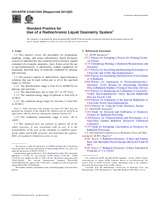Potrebujeme váš súhlas na využitie jednotlivých dát, aby sa vám okrem iného mohli ukazovať informácie týkajúce sa vašich záujmov. Súhlas udelíte kliknutím na tlačidlo „OK“.
ASTM/ISO 51540-04(2012)
Standard Practice for Use of a Radiochromic Liquid Dosimetry System (Withdrawn 2020)
Automaticky preložený názov:
Štandardná prax pre použitie jedného Radiochromic Liquid dozimetria systému
NORMA vydaná dňa 21.3.2012
Informácie o norme:
Označenie normy: ASTM/ISO 51540-04(2012)
Poznámka: NEPLATNÁ
Dátum vydania normy: 21.3.2012
Kód tovaru: NS-886
Počet strán: 7
Približná hmotnosť: 21 g (0.05 libier)
Krajina: Americká technická norma
Kategória: Technické normy ASTM
Kategórie - podobné normy:
Anotácia textu normy ASTM/ISO 51540-04(2012) :
Keywords:
absorbed dose, dosimetry, electron beams, gamma radiation, ionizing radiation, liquid dosimeter, quality control, radiation processing, radiochromic dosimetry, radiochromic liquid, radiochromic solution, ICS 17.240, ICS Number Code 17.240 (Radiation measurements)
Doplňujúce informácie
| Significance and Use |
|
4.1 The radiochromic liquid dosimetry system provides a means of measuring absorbed dose in materials (5-7). Under the influence of ionizing radiation, chemical reactions take place in the radiochromic solution modifying the amplitudes of optical absorption bands (8-10). Absorbance values are measured at the selected wavelength(s) within these affected absorption bands (see also ISO/ASTM Guide 51261). 4.2 In the use of a specific dosimetry system, a calibration curve or response function relates the dosimeter’s response to an absorbed dose traceable to a nationally or internationally recognized standard (11, 12). 4.3 The absorbed dose that is measured is usually specified in water. Absorbed dose in other materials may be evaluated by applying the conversion factors discussed in ISO/ASTM Guide 51261. NOTE 2—For a comprehensive discussion of various dosimetry methods applicable to the radiation types and energies discussed in this practice, see ICRU Reports 14, 17, 34, 35, and 37. 4.4 These dosimetry systems may be used in the industrial radiation processing of a variety of products, for example the sterilization of medical devices and radiation processing of foods (5, 7, 13). 4.5 The available dynamic range indicated in 1.2.1 is achieved by using a variety of radiochromic leuco dyes (Table 1) in a variety of solutions (Table 2). <4.6 The ingredients of the solutions, in particular the solvents, can be varied so as to simulate a number of materials in terms of the photon mass energy-absorption coefficients, (μen/ρ), for X-rays and gamma-rays and electron mass collision stopping powers, [(1/ρ) dE/dx], over a broad spectral energy range from 0.01 to 100 MeV (18). For special applications certain tissue-equivalent radiochromic solutions have been designed to simulate various materials and anatomical tissues, in terms of values of (μen/ρ) for photons and [(1/ρ) dE/dx] for electrons (18) (see also ICRU Report 44). Tabulations of the values of (μen/ρ) for water (19), the anatomical tissues (17, 19), and three specially designed radiochromic solutions, for photons over the energy range from 0.01 to 20 MeV, and tabulations of the values of [(1/ρ) dE/dx] (17) for water, the tissues and the radiochromic solutions for electrons over the energy range from 0.01 to 20 MeV are given in Refs (12, 13, 18). For additional information see ISO/ASTM Guide 51261, ASTM Practice E 666, and ICRU Reports 14, 17, 35, 37, and 44. |
| 1. Scope |
|
1.1 This practice covers the procedures for preparation, handling, testing, and using radiochromic liquid dosimetry systems of radiochromic dye solutions held in sealed or capped containers (for example, ampoules, vials). It also covers the use of spectrophotometric or photometric readout equipment for measuring absorbed dose in materials irradiated by photons and electrons. 1.2 This practice applies to radiochromic liquid dosimeter solutions that can be used within part or all of the specified ranges as follows: 1.2.1 The absorbed dose range is from 0.5 to 40 000 Gy for photons and electrons. 1.2.2 The absorbed dose rate is from 10−3 to 1011 Gy/s. 1.2.3 The radiation energy range for photons is from 0.01 to 20 MeV. 1.2.4 The radiation energy range for electrons is from 0.01 to 20 MeV. NOTE 1—Since electrons with energies less than 0.01 MeV may not penetrate the container of the solution, the solutions may be stirred in an open beaker with the electrons entering the solutions directly (1). 1.2.5 The irradiation temperature range is from −40 to +60°C. 1.3 This standard does not purport to address all of the safety concerns, if any, associated with its use. It is the responsibility of the user of this standard to establish appropriate safety and health practices and determine the applicability of regulatory limitations prior to use. |
Podobné normy:
Historická
1.11.2011
Historická
1.1.2010
Historická
1.1.2013
Historická
1.6.2013
Historická
1.1.2013
Historická
1.1.2013
Odporúčame:
EviZak - všetky zákony vrátane ich evidencie na jednom mieste
Poskytovanie aktuálnych informácií o legislatívnych predpisoch vyhlásených v Zbierke zákonov od roku 1945.
Aktualizácia 2x v mesiaci !
Chcete vedieť viac informácii ? Pozrite sa na túto stránku.



 ASTM E2450-11
ASTM E2450-11 ASTM E261-10
ASTM E261-10 ASTM E262-13
ASTM E262-13 ASTM E263-13
ASTM E263-13 ASTM E264-08(2013)..
ASTM E264-08(2013).. ASTM E265-07(2013)..
ASTM E265-07(2013)..
 Cookies
Cookies
